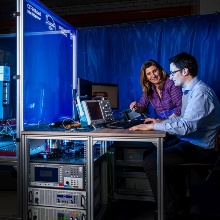The researchers working with Prof. Dr. Nejila Parspour at the iew develop wireless electrical road networks, where electric cars and commercial vehicles can be automatically charged, either when moving or stationary, for example when parked on a parking lot or waiting at traffic lights. To enable this, inductors are embedded into the road surface. As soon as the vehicle drives over these it activates the charge coils in the road and electrical energy is transmitted to the vehicle via a magnetic field. This technology can significantly increase the range of electric vehicles. Because public charging stations are scarce, inductive charging would increase capacity at a relatively comparable cost. Electric vehicles could then be charged on the way to work, or while parked, and would no longer have to be plugged in overnight. Prof. Dr. Nejila sees the most potential for further development in the analysis of energy routes.
Improved positioning tolerance, better efficiency
The team working with Prof. Parspour has already applied for patents for multiple inventions, in order to advance the idea of inductive stationary charging and dynamic inductive charging. “One of these important inventions is based on position tolerance, which makes inductive charging possible, regardless of vehicle height and width”, says Nejila Parspour. “Furthermore, the efficiency of the systems developed by the iew has been improved and is now over 95 percent.”
Other inventions that have already been patented focus on the field of foreign object detection. This enables the charging system to recognize if a foreign object that might become hot is lying on the inductor. Furthermore, the researchers at iew are also involved in several other projects, for example 48-volt based charging whilst driving, and another project that examines the economic viability and the size of the components needed for the charging system. Inductive charging technology not only requires the necessary infrastructure – so, the coils in the energy route –, but also the receiver coils, which must not only be efficient, but also as light as possible. The aim is to build a stable system with as few components as possible. This reduces costs, which is important for economic viability, but it also saves space and reduces weight, which are important factors for an electric vehicle.
Patents have been registered for these inventions (EP pending). The Technologie-Lizenz-Büro (TLB) GmbH supports the University of Stuttgart with issues surrounding patenting and marketing innovations. TLB has been tasked with ensuring that the implementation of these pioneering technologies is economically viable, and it also offers companies the opportunity to work with them and also licenses property rights.
| Contact | Prof. Dr. Nejila Parspour, Institute for Electrical Energy Conversion, Tel. +49 711 685-67819, email info@iew.uni-stuttgart.de |
|---|


